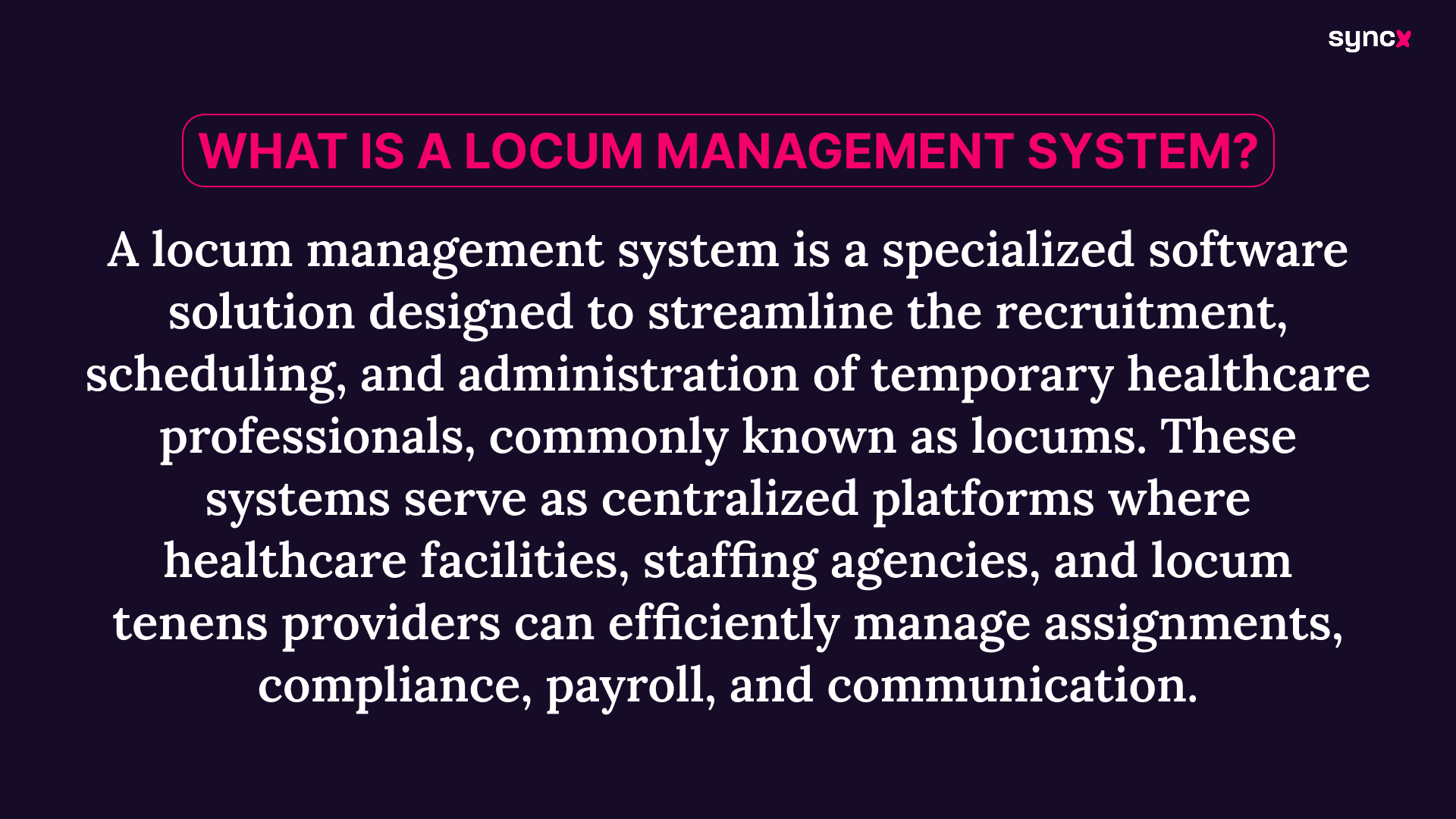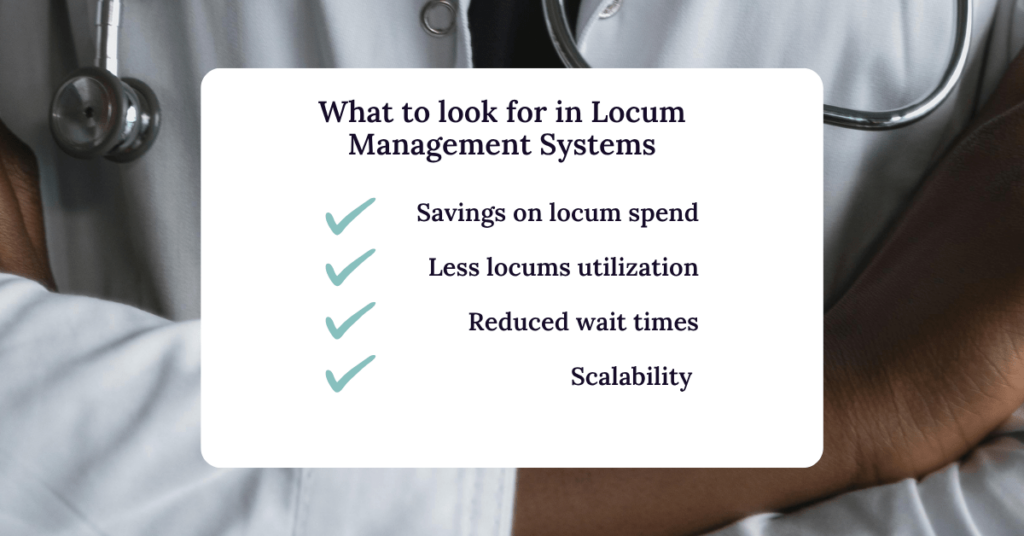How a Locum Management System Works
Locum tenens staffing has reached a tipping point. Facilities face relentless pressure to maintain coverage amid physician shortages, seasonal surges, and unexpected absences. Endless credential verification emails, frantic last-minute scheduling, and overreliance on agencies with high fees are no longer sustainable for organizations that value efficiency and patient care.
Locum management systems have emerged as the definitive answer to these challenges. The right system doesn’t just fill shifts. It provides visibility, reduces risk, and unlocks strategic workforce planning.
In this guide, we’ll examine essential components of locums management and consider operational advantages alongside implementation considerations. Most importantly, we’ll demonstrate how solutions like Syncx deliver a purpose-built approach that addresses the unique complexities of locum tenens staffing.

What Is a Locum Management System?
A locum management system is a specialized management solution designed to streamline the recruitment, scheduling, and administration of temporary healthcare professionals, commonly known as locums. They are more frequently called Locum Tenens (or Locums) MSPs. These platforms serve as a centralized hub for healthcare facilities, staffing agencies, and locum tenens providers to efficiently manage everything from assignments to compliance to invoicing and communication.
In short, the goal of locum management is to provide expert insights into locums hiring while at the same time automating traditionally manual processes, with the shared goal of reducing administrative burdens while improving accuracy and operational efficiency in temporary staffing workflows.
What Do Locum Management Systems Offer?
Locum management systems provide a variety of tools to alleviate staffing burdens. Let’s take a deep dive into each of the areas to understand how these systems support healthcare facilities.
Simplified Recruitment and Onboarding
Locum management systems allow healthcare organizations to post vacancies, screen candidates, and manage applications in a unified interface. They often include credential tracking to verify qualifications, certifications, and licenses in order to maximize the efficiency of those processes. Automated onboarding workflows further reduce delays by tracking credentialing, digitizing contracts and invoices, and streamlining privileging.
Efficient Scheduling and Assignment Management
Dynamic scheduling features common to locum management systems allow administrators to match professionals with shifts based on specialty, availability, and location. Real-time updates help prevent double bookings or gaps in coverage, while integrated calendars and notifications keep all parties informed of schedule changes.
Automated Invoicing
Locum management software eliminates manual timesheet errors by tracking worked hours directly within the system. It generates invoices and processes payments based on predetermined rates, integrating seamlessly with accounting software to ensure timely and accurate compensation for locums and clearer financial reporting for clients.
Compliance and Documentation Tracking
Maintaining up-to-date records is critical in healthcare staffing. Locum management systems store and monitor essential documents such as immunizations, background checks, and malpractice insurance, sending alerts for renewals or expirations. This reduces legal risks and ensures adherence to industry standards.
Communication and Collaboration Tools
Built-in messaging, email reminders, approval notices, and portal access facilitate clear communication between providers, agencies, and healthcare facilities. Some systems include mobile apps for instant updates, allowing providers or agencies to confirm assignments, submit documentation, or request support on the go.
Analytics and Reporting Capabilities
Data-driven insights help optimize staffing strategies by analyzing trends in locum utilization, costs, and performance metrics. Customizable reports enable administrators to assess operational efficiency, forecast demand, and make informed decisions for future staffing needs.
Why Do Facilities Use Locum Management?
Healthcare facilities rely on locum management systems to reduce locum spend and give them greater control over the staffing process. These systems provide a structured approach to sourcing, vetting, and deploying temporary clinicians, ensuring continuity in service delivery and reducing dependence on agencies. They also automate administrative tasks such as credential verification, scheduling, and payroll, allowing facilities to reduce overhead costs and minimize errors associated with manual processes. Additionally, locum management platforms offer visibility into staffing trends, enabling proactive workforce planning and better resource allocation.
Ultimately, locum management systems create a bridge between temporary agencies and organizations that gives the facility greater control over staffing.
What Are the Pros and Cons of a Locum Management System?
Locum management systems offer significant advantages but also come with challenges. Below is a structured comparison:
| Aspect | Pros | Cons |
| Efficiency | Automates scheduling, invoicing, and compliance checks, saving time and reducing manual errors. | Initial setup and staff training require time investment. |
| Cost-Effectiveness | Lowers administrative costs and optimizes locum utilization, reducing expenses over time. | Organizations must still cover agency fees. |
| Compliance | Centralized tracking of licenses, certifications, and insurance minimizes regulatory risks. | Document tracking is common, but full credentialing process is typically owned and managed by the facility. |
| Scalability | Easily adapts to fluctuating staffing needs, ideal for seasonal demand or rapid growth. | Over-reliance on locums may impact long-term team dynamics. |
| Communication | Integrated messaging and portals improve coordination between agencies and facilities. | Technical issues (e.g., software downtime) can disrupt workflows. |
| Data Insights | Reporting tools help analyze staffing patterns and optimize future hiring decisions. | Data overload without proper training may hinder usability. |
What Should You Look for in a Strong Locums Management System?
A robust Locum Management System should offer comprehensive features that address the unique challenges of temporary healthcare staffing. However, the most critical feature of a strong locums management is that it saves the facility money while reducing locum utilization. Look for servicers that provide strong statistics about savings and utilization rates.
Ease of use is also critical as both administrators and locums agencies should be able to navigate the platform intuitively. Scheduling automation is another key factor; the system should handle shift assignments, conflicts, and last-minute changes with real-time updates to avoid gaps in coverage.
Compliance tracking capabilities are non-negotiable, as healthcare facilities must ensure all locums meet licensing, certification, and insurance requirements. The best systems automate reminders for expiring credentials and store documents securely.
Invoicing integration streamlines financial workflows, reducing errors in timesheet management and payment processing. Those integrations should help the facility flag invoicing disputes in order to prevent costly errors.
Finally, scalability ensures the system grows with your organization, whether you’re a small clinic or a multi-facility hospital network.

A Single Solution for Locums Management
Managing locum tenens staffing shouldn’t mean juggling disconnected tools, manual spreadsheets, and compliance headaches. Syncx simplifies the entire process with an all-in-one platform designed for healthcare, by workforce experts.
From automated credential tracking and intelligent scheduling to seamless billing and real-time communication, Syncx ensures your facility or agency operates at peak efficiency—while keeping patient care at the forefront.
Ready to see the difference? Get a free Syncx Demo and discover how unified locum management can save time, reduce costs, and eliminate administrative chaos.